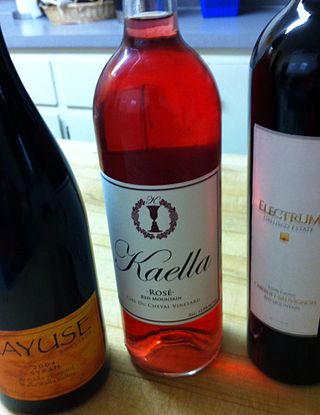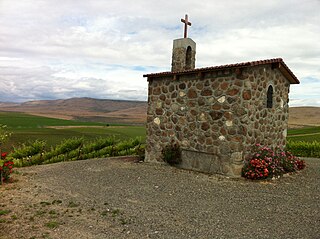
The Livermore Valley AVA is an American Viticultural Area in Alameda County, California, surrounding the city of Livermore in the Tri-Valley region. Both the AVA and the city are named after Robert Livermore, a landowner whose holdings encompassed the valley. The groundwater basin underlying the valley is the Livermore Basin, the largest sub-unit of which is the Mocho Subbasin. The Livermore Basin is one of five aquifers in the San Francisco Bay Area that supply most of the metropolitan Bay Area population. The entire Livermore Basin aquifer faces a concern over elevated total dissolved solids by the year 2020 due to an expanding human population leading to higher rates of return water flows to the aquifer containing certain salts.

The Yadkin Valley AVA is an American Viticultural Area that includes land in seven counties of northwestern North Carolina. The AVA encompasses an area of approximately 1,400,000 acres (5,666 km2) in the Yadkin River valley. The Yadkin Valley AVA includes all of Wilkes, Surry, and Yadkin counties, and parts of Davie, Davidson, Forsyth, and Stokes counties. Yadkin Valley is home to 45 wineries.
DeLille Cellars is a winery in Woodinville, Washington, USA. Located in the Hollywood District of Woodinville at the former Redhook Brewery, DeLille's hospitality venues include The Tasting Room and The Restaurant at DeLille Cellars. DeLille Cellars specializes in wines using the Bordeaux grape varieties: Cabernet Sauvignon, Merlot, Cabernet Franc, and Petit Verdot. In 2000, DeLille won The New York TimesWine Today.com "Winery of the Year" award. It is one of Washington state's premier cult wines.

Stag's Leap Wine Cellars is a winery founded by Warren Winiarski in 1970 and based in the Stags Leap District of Napa Valley, California.

Warren Winiarski was an American Napa Valley winemaker and the founder and proprietor of Stag's Leap Wine Cellars.

Heitz Cellar is a California wine producer located within Napa Valley east of the town of St. Helena. An early modern era Napa Valley presence and pioneering exponent of French oak, the estate enjoys a historical renown with the success of its Martha's Vineyard Cabernet Sauvignon, and has also been described as a "master of Grignolino".

Washington wine is a wine produced from grape varieties grown in the U.S. state of Washington. Washington ranks second in the United States in the production of wine. By 2017, the state had over 55,000 acres (220 km2) of vineyards, a harvest of 229,000 short tons (208,000 t) of grapes, and exports going to over 40 countries around the world from the 940+ wineries located in the state. While there are some viticultural activities in the cooler, wetter western half of the state, the majority (99.9%) of wine grape production takes place in the shrub-steppe eastern half. The rain shadow of the Cascade Range leaves the Columbia River Basin with around 8 inches (200 mm) of annual rain fall, making irrigation and water rights of paramount interest to the Washington wine industry. Viticulture in the state is also influenced by long sunlight hours and consistent temperatures.
The state of Oregon in the United States has established an international reputation for its production of wine, ranking fourth in the country behind California, Washington, and New York. Oregon has several different growing regions within the state's borders that are well-suited to the cultivation of grapes; additional regions straddle the border between Oregon and the states of Washington and Idaho. Wine making dates back to pioneer times in the 1840s, with commercial production beginning in the 1960s.

Red Mountain is an American Viticultural Area (AVA) that encompasses the local region surrounding Red Mountain in Benton County, Washington. The viticultural area was formally recognized on June 11, 2001 by the Bureau of Alcohol, Tobacco and Firearms (ATF), Treasury after reviewing the petition submitted by Lorne Jacobson of Hedges Cellars to establish an area known as "Red Mountain." It lies entirely within the Yakima Valley and vast Columbia Valley appellations and is the smallest AVA in the state at only 4,040 acres (6.31 sq mi) in area and lies between Benton City and the City of West Richland. The area has more than 2,225 acres (900 ha) under cultivation of primarily red varietals including Cabernet Sauvignon, Merlot, Sangiovese, Cabernet Franc and Syrah. The reputation of the area's wines has brought Red Mountain worldwide attention and acclaim for producing some of the most desired Washington State vintage wines.

Walla Walla Valley is an American Viticultural Area (AVA) located within Washington state and extending partly into the northeastern corner of Oregon. The wine region is entirely included within the larger Columbia Valley AVA. In addition to grapes, the area produces sweet onions, wheat and strawberries After the Yakima Valley AVA, the Walla Walla AVA has the second highest concentration of vineyards and wineries in Washington State. Walla Walla hosts about 140 wineries. The area was recognized on March 7, 1984 by the Bureau of Alcohol, Tobacco and Firearms (ATF), Treasury after reviewing the petition submitted by Mr. Richard L Small, President of the Walla Walla Valley Winegrowers Association, for the establishment of a viticultural area in southeast Washington and northeast Oregon, east of Lake Wallula, to be known as "Walls Walls Valley." At the time, Walla Walla Valley viticultural area was approximately 178,560 acres (279 sq mi) with two bonded wineries and about 60 acres (24 ha) from several vineyards.

J. Lohr Vineyards & Wines is a winemaking company headquartered in San Jose, California, with over 4,000 acres of estate vineyards in the Paso Robles AVA in San Luis Obispo County, Arroyo Seco and Santa Lucia Highlands AVAs in Monterey County, and the St. Helena AVA in Napa Valley, California. The family-owned and operated company was founded by Jerry Lohr in 1974. The company operates wineries in San Jose, Paso Robles, and Greenfield, California. In 2013, Steve Lohr was appointed CEO of the company. J. Lohr Vineyards & Wines’ product portfolio includes eight tiers of wine: J. Lohr Signature, J. Lohr Cuvée Series, J. Lohr Vineyard Series, J. Lohr Gesture, J. Lohr Pure Paso Proprietary Red Wine, J. Lohr Monterey Roots, J. Lohr Estates and ARIEL Vineyards. The portfolio also includes specialty brands Cypress Vineyards and Painter Bridge. J. Lohr ranks among the top 25 wine producers in the United States, with annual US sales exceeding 1.8 million cases.

The Stags Leap District AVA is an American Viticultural Area located within the Napa Valley AVA 6 miles (9.7 km) north of the city of Napa, California. The Stags Leap District was the first appellation to be designated an AVA based on the unique terroir characteristics of its soil. The soil of this region include loam and clay sediments from the Napa River and volcanic soil deposits left over from erosion of the Vaca Mountains. Like many Napa Valley AVAs, Stags Leap District is particularly known for its Cabernet Sauvignon. In 1976 at the Judgment of Paris wine tasting, the 1973 Stag's Leap Wine Cellars Cabernet from the area that would become this AVA won first place in the red wine category, beating out classified Bordeaux estates. Today, the Stags Leap District is home to twenty different wineries.

Arizona wine refers to wine made from grapes grown in the U.S. state of Arizona. There are three major regions of vineyards and wineries in Arizona:

California wine production has a rich viticulture history since 1680 when Spanish Jesuit missionaries planted Vitis vinifera vines native to the Mediterranean region in their established missions to produce wine for religious services. In the 1770s, Spanish missionaries continued the practice under the direction of the Father Junípero Serra who planted California's first vineyard at Mission San Juan Capistrano.

Grand Valley is an American Viticultural Area (AVA) within Mesa County, Colorado located in a high-altitude river valley surrounding the county seat of Grand Junction and stretching 24 miles (39 km) east-west between the municipalities of Palisade and Fruita. It lies approximately 200 miles (320 km) west-southwest of Denver along Interstate 70. The river valley encompasses 75,990 acres (118.73 sq mi), with an average elevation between 4,000 and 5,000 feet (1,200–1,500 m) above sea level and is defined by an irrigated agricultural area served by canals in the Grand Valley of the Colorado River. Grand Valley AVA was established by the Bureau of Alcohol, Tobacco and Firearms (ATF) on December 26, 1991, upon the petition submitted by Mr. James Seewald of Vintage Colorado Cellars Winery, and the first viticultural area registered in the Centennial State. In 2001, the smaller West Elks AVA, located southeast of Grand Valley, became the state's second federally-designated AVA.

The Old Mission Peninsula AVA is an American Viticultural Area located in Grand Traverse County, Michigan known for well-regarded Michigan wine. The Old Mission Peninsula extends northward from Traverse City into the Grand Traverse Bay of Lake Michigan, ending at Old Mission Point. The peninsula is 19 miles (31 km) long by 3 miles (5 km) wide at its widest point. The climate on the peninsula is moderated by the surrounding waters, helping to prevent frost during the growing season. Grape varietals suitable to cool climates, such as Riesling, Chardonnay, Gewürztraminer, Pinot gris, Pinot noir, Cabernet Franc, and Merlot do best in the Old Mission Peninsula AVA.

David Lake was a Washington winemaker and Master of Wine. Born in England to Canadian parents, Lake started in the wine industry working for a British wholesaler. In 1975 he earned his Master of Wine certification before traveling to the United States to enroll into the enology program of University of California-Davis. In 1978 he accepted a position of enologist with the Washington winery Associated Vintners where he soon rose to the position of chief winemaker. Among Lake's accomplishments was releasing Washington's first single vineyard designated wines and making the states first Cabernet franc, Syrah and Pinot gris wines. He was the first US winemaker to hold a Master of Wine accreditation.

Champoux Vineyard is a grape growing estate located in the Horse Heaven Hills AVA of Washington state. Grapes grown in the vineyard have been used to produce some of the most critically acclaimed Washington wines with the name Champoux regularly being featured on vineyard designated wines. Paul Gregutt, wine writer for the Seattle Times and Wine Enthusiast, list Champoux as one of the "top ten" vineyards in the entire state. Cabernet Sauvignon grapes from Champoux vineyards were featured in the consecutive 100 point Robert Parker rated wines from Quilceda Creek Vintners for the 2002 and 2003 vintages.

Boushey Vineyard is a grape-growing estate located in the Yakima Valley AVA, north of Grandview, Washington. Grapes grown in the vineyard have been used to produce some of the most critically acclaimed Washington wines with the name Boushey regularly being featured on vineyard designated wines. Paul Gregutt, wine writer for the Seattle Times and Wine Enthusiast, list Boushey as one of the "top ten" vineyards in the entire state. The vineyard is owned and managed by viticulturist Dick Boushey who was honored in 2002 by the Washington State Wine Commission as Washington's "Grower of the Year" and in 2007 by Wine & Spirits as their "Grower of the Year". After Red Willow Vineyard, which was planted with David Lake and Mike Sauer, Boushey was one of the first Washington wine growers to plant Syrah. Today, Boushey Vineyard is considered by wine experts such as Jon Bonné to be "One of the state's top Syrah spots" with many Washington Syrahs made from Boushey's grape receiving critical acclaim.

Red Willow Vineyard is a grape-growing estate located in the far western end of Yakima Valley AVA, within the Yakama Indian Reservation. Beginning with their relationship with Columbia Winery and Master of Wine David Lake, grapes from Red Willow have been used to produce some of the most critically acclaimed Washington wines with the vineyard's name regularly being featured on vineyard designated wines. Paul Gregutt, wine writer for the Seattle Times and Wine Enthusiast, list Red Willow as one of the "top ten" vineyards in the entire state.



















